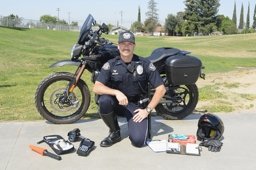What’s in a rider’s emergency kit?


Emergency kits have come a long way from those our fathers used to swear by. In so much of the same way, injury profiles of injured riders have changed as well. So has the number and kinds of dangerous situations riders are coming face-to-face with, on and off the bike.
But being equipped with the right knowledge and tools can help immensely in dealing with unexpected — and unfortunate — situations.
Here are some tools that multiple professional organisations such as the American Red Cross, the Wilderness Medical Society, and a host of police and EMS groups recommend.
Keep in mind that they should be easily accessible — always.
1. Less major injuries like abrasions — even road rash — can be attended to with soap and water to get rid of potentially harmful bacteria that live in dirt, like Clostridia. Clostridium causes tetanus as well as gas gangrene — both potentially lethal conditions. If soap and water aren’t readily available, premoistened antibacterial wipes or alcohol-based gels, like Purell, work quite well for most bacteria. It will sting — because alcohol has that general effect — but it will also help to disinfect.
2. Using a nonstick dressing will spare you a lot of pain on the daily if yours needs constant changing.
3. A pair of liquid-impervious gloves will come in pretty handy if attending to someone else is needed. It will help prevent infections from occurring with contact from open wounds and lesions. Nitrile gloves are ideal and will protect you from blood-borne infections such as Hepatitis B or C, and HIV, to name a few. A Band-Aid or two takes up little space and has a myriad of uses, from blisters to small cuts.
4. Tourniquets — which stop blood circulation in the arteries — come in two general types and work equally well in stopping bleeding. There’s the windlass type exemplified by the CAT (Combat Application Tourniquet), that tightens with each windlass turn. The other is elastic, tightens with each wrap and is exemplified by the SWAT-T (Stretch, Wrap, And Tuck). Both are commercially available, but read the instructions properly before use.

5. Another must-have in your kit is a procoagulant dressing, preferably with kaolin (found in clay) so that your natural clotting process is sped up. These dressings may be wrapped around a large bleeding surface like really deep road rash, or packed into large punctures and should only be removed by professionals.
6. Just like how learning how to ride right is important, learning CPR comes in a close second. So consider taking a course on it. You’ll never know when a fellow rider may need it, especially our older guys.
